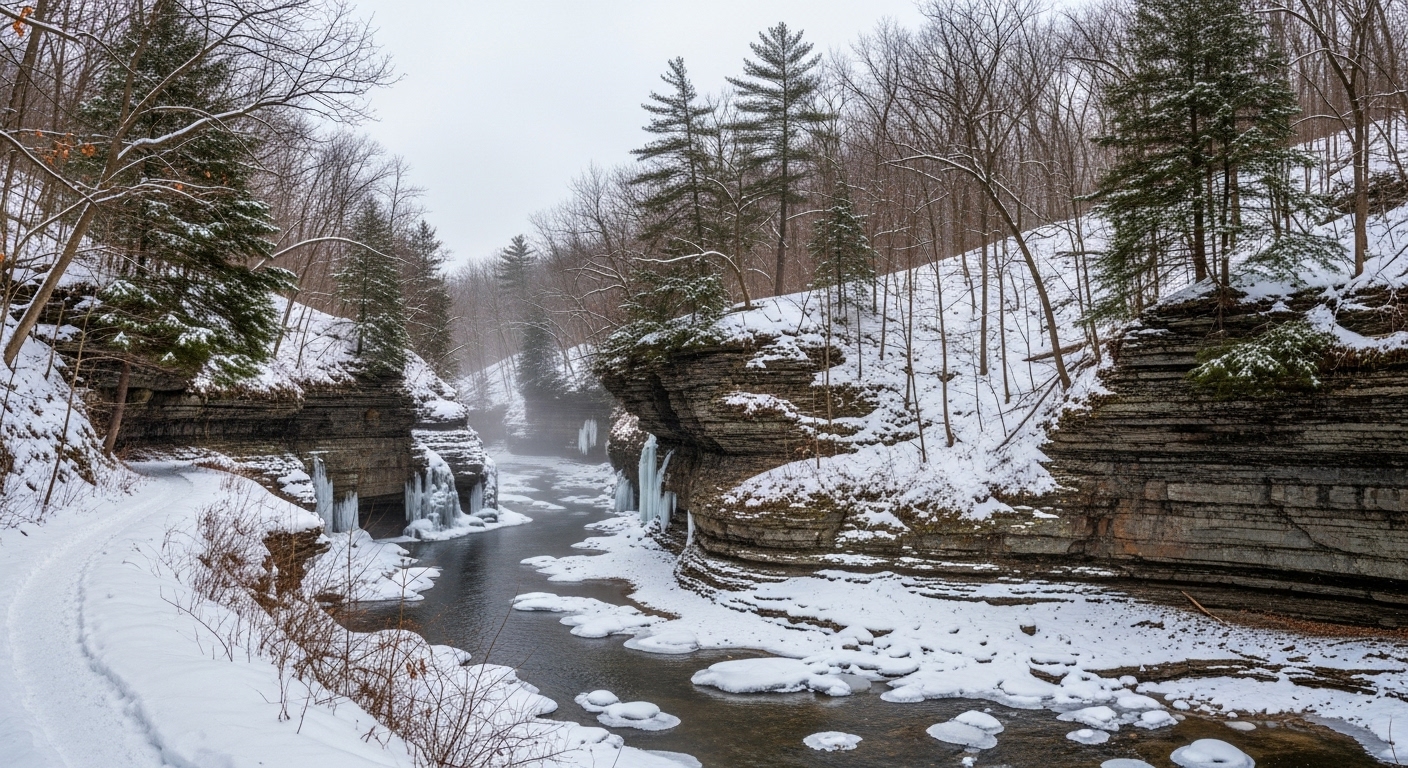Wintergreen Gorge is one of northwest Pennsylvania’s most beloved natural areas—a tranquil stretch of forest, waterfalls, and rugged terrain located on the campus of Penn State Behrend in Erie. Known for its picturesque creek, steep shale walls, and rich biodiversity, the gorge is a favorite destination for hikers, nature photographers, students, and locals seeking an easy escape into nature. This article explores the history, features, trail system, and environmental importance of Wintergreen Gorge.
1. Introduction to Wintergreen Gorge
Wintergreen Gorge is a 3,980-foot-long natural gorge carved over thousands of years by Fourmile Creek. Its cool microclimate, flowing water, and shaded forest canopy create a peaceful environment ideal for outdoor recreation. Despite being close to academic buildings and residential neighborhoods, the gorge feels remote and wild.
The area is recognized as a significant ecological site and serves as both a recreational space and an outdoor classroom for geology, biology, and environmental science students.
2. Geological Formation and Landscape
Shale Walls and Exposed Ledges
The gorge is primarily composed of shale and siltstone layers that eroded over millennia. These rock layers form tall, narrow walls that run alongside the creek, offering dramatic views for hikers.
Natural Terraces and Water Features
Wintergreen Gorge contains multiple small waterfalls, rapids, and natural pools along Fourmile Creek. These features change with the seasons, creating unique scenery throughout the year.
Glacial History
The region was shaped by glacial retreat at the end of the last Ice Age. As the glaciers melted, they carved the creek channel deeper, forming the steep gorge that exists today.
3. Trails and Outdoor Activities
Main Hiking Trail
The most popular route is the Wintergreen Gorge Trail, an accessible path that parallels the creek. The trail is generally classified as easy to moderate, depending on recent weather conditions and water levels.
Footbridges and Creek Crossings
Several wooden bridges help hikers cross the water. During the summer, some visitors explore the creek bed itself, stepping over stones and shallow pools.
Nature Observation
Hikers can enjoy:
-
Birds such as robins, thrushes, and hawks
-
Woodland mammals including deer and chipmunks
-
Seasonal wildflowers and moss-covered rocks
The peaceful environment makes it ideal for slow-paced nature walks.
4. Seasonal Highlights
Spring
Snowmelt increases water flow, enhancing the sound and movement of the creek. Wildflowers bloom along the forest floor.
Summer
Lush greenery creates a cool, shaded retreat. Many visitors come to escape the heat and enjoy the tranquil atmosphere.
Autumn
Fall foliage transforms the gorge into a vivid display of red, orange, and gold—one of the most beautiful seasons for photography.
Winter
Parts of the creek freeze, forming hanging icicles and shimmering ice layers along the shale walls. While stunning, winter hiking requires caution.
5. Ecological Importance
Biodiversity Hotspot
Wintergreen Gorge supports a wide range of plant and animal life thanks to its sheltered microclimate and continuous water source.
Riparian Habitat
The creek provides critical habitat for aquatic organisms, insects, amphibians, and fish. Healthy riparian zones also reduce erosion and improve water quality.
Conservation Efforts
Penn State Behrend and local environmental organizations maintain the trail, protect the creek from pollution, and monitor invasive species. Visitors are encouraged to follow Leave No Trace practices.
6. History and Cultural Background
Early Use
Indigenous peoples once traveled through the region using the creek as a natural pathway. Later, settlers recognized the gorge as a source of water and natural resources.
Educational Value
Since the establishment of Penn State Behrend, Wintergreen Gorge has served as an open-air laboratory where students study:
-
Geology
-
Watersheds
-
Plant species
-
Environmental systems
Its accessibility makes it a living classroom as well as a recreational feature.
7. Photography Tips for Wintergreen Gorge
Wintergreen Gorge offers diverse scenery for both beginner and experienced photographers.
Best Locations
-
Creek-level viewpoints
-
Small waterfalls and cascades
-
Elevated overlooks near the shale cliffs
Lighting Conditions
Because the gorge is shaded, lighting is soft and diffused—excellent for long-exposure shots of running water.
Recommended Gear
-
Tripod for stability
-
Wide-angle lens to capture the gorge walls
-
Waterproof shoes for close-to-water photography
8. How to Visit and What to Know
Location
Wintergreen Gorge is located next to Penn State Behrend in Erie, Pennsylvania. The main trailhead is near Cooper Road and the Behrend athletic fields.
Trail Safety
-
Wear sturdy hiking shoes
-
Avoid steep drops and unstable rocks
-
Keep pets leashed
-
Be cautious after heavy rain, as rocks can become slippery
Parking
Free parking is available near the trailhead, though it may become limited during high-use hours or academic events.
Conclusion
Wintergreen Gorge is a serene outdoor destination that blends natural beauty, geological history, and educational value. Whether you’re seeking a peaceful hike, a scenic photography location, or a place to observe local wildlife, the gorge offers a refreshing escape from urban life. Its combination of accessibility and wilderness charm has made it one of Erie’s most treasured natural attractions.
